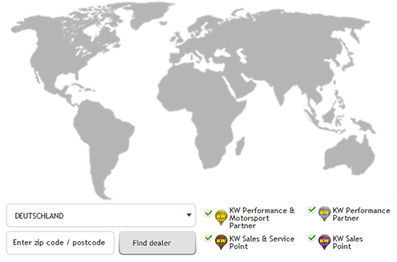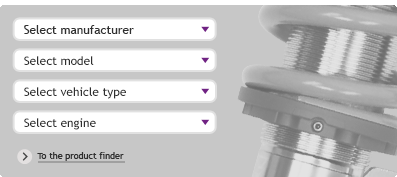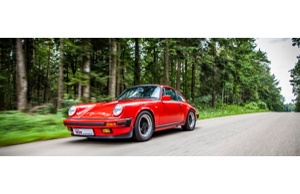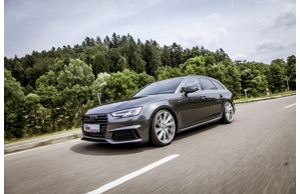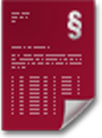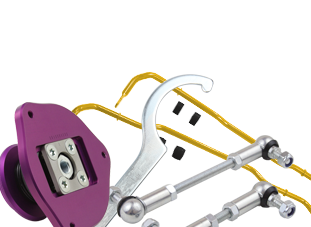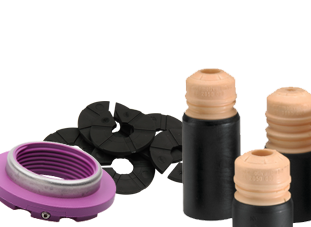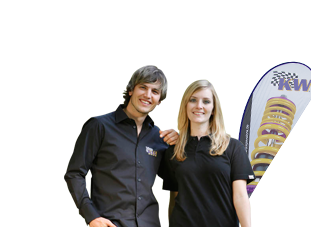The KW coilover suspension kit
Lowering to your demand and high quality components
for a long life
Unlike traditional standard- and sports suspension solutions, KW coilovers have an adjustable spring seat. This allows lowering via a trapezoid thread.
Another difference to the conventional series strut is the longer suspension travel, this is achieved by using shortened coilover strut housings. Therefore even at maximum lowering the remaining spring travel is not affected.
Continuous lowering
The lowering of a KW coilover kit has to be adjusted at the front axle directly at tje 100 percent corrosion-resistant KW stainless steel strut after the McPherson method of construction while the kit is installed. Through the dirt-resistant trapezoid thread and the long life polyamid collar, the adjustment is easy to make, even after years.
With the adjustment technology used by KW that works even under spring preload. Depending on the vehicle type, the level control of the lowering at the rear axle occurs either directly at the strut after McPherson method of construction (for example Subaru Impreza); or via the KW rear axle height adjustment which is made of polyamid, at the spring retainer. Also here, the lowering can be adjusted via the coilover spring perche quick and easy when the kit is installed.
KW dampers and KW springs
A coordinated unit for a sporty driving experience. High-quality components, a vehicle-specific damper manufacturing and damper setup as well as many years of experience in development of suspension kits for the international motor sport is what the KW damper technology characterizes.
The KW coilovers for road vehicles are built after the successful twin-tube damping principle which is also often used for active regulation series suspensions. At twin-tube dampers, the piston housing (inner tube, also called rebound housing) and the differential housing (outer tube) are put together.

Spring perch
The KW spring perch is a completely underrated component. It not only holds the helper spring and main spring at the right position, but it also minimizes the vibration noise of the springs. Depending on the vehicle type and application, KW manufactures the spring perch of high quality aluminum alloy or a polyamide composite material. Whether made of aluminum or the composite material which is also rust resistant, the spring perch which is painted in the typical KW purple is very light weight.



Helper spring
The so-called helper spring is made of high quality chrome silicon steel in flat wire design. It keeps the main spring above the polyamide spring perch under tension, no matter what level of lowering. As soon as the weight of the vehicle presses on the helper spring, all windings are pressed together - the spring "goes on block".

Polyamide intermediate ring
The intermediate rings made of a light poyamide composite material used by KW not only hold the springs, but also minimize the vibration noise of the springs. Furthermore they isolate the rolling noices of the body.



Bump stop with integrated dust protection system
The dust cover prevents water and dirt particles reaching the piston rod seal package. Depending on the manufacturer, the dust cover is made of elastomer plastic and also serves as a passive suspension element.

High strength main spring
The high-strength spring made of chrome-silicon steel is vehicle specific adjusted in the respective suspension damper in its spring rate for long life it is multicoated. It is also called the main spring at coilovers. With brands such as KW, the spring "sits" after years just minimally.
Suspension spring
Not only the damper or vibration shock absorber of a KW coilover kit affects the springing behaviour but also the KW spring does. The resulting kinetic energy is stored by the spring during compression and converted into heat energy from the damper.
The spring rate tells the amount of force (N) that has to act to the spring, so that it immerses by a millimeter. Simply explained: the higher the spring rate, the stiffer the spring, and the more force must act on the spring to compress it
Linear spring rate
If a suspension spring is winded linear, the force increases in direct proportion to the compression travel. A spring rate of 70 Newton (N)/mm means that 70 N must act on the spring to compress it by one millimeter.

Progressive spring rate
At a progressive spring rate, the suspension spring consits of differently strong spring windings. When a force acts, the weak windings give up at first and then the stronger spring windings. The same effect can also be achieved by the use of two springs placed on top of each other.


Composite collar for height adjustment
KW uses a threaded ring made of a resistant polyamide composite material with a stainless steel insert. Even if dirt particles such as brake dust or sand grains hit the polyamide collar will not be damaged. If anodized aluminum spring perchs are used after repeated lowering adjustment friction of any contamination may cause microcracks on the anodized surface. If the unprotected aluminum threaded ring directly touches the steel or stainless-steel strut thread oxidation will occur. In the worst case, height adjustmant will now not be possible anymore. With the durable KW coilovers in inox-line and the used polyamide collar, this is not the case.

Stainless steel "inox-line" strut housing
with integrated shock absorber
The strut housing of KW coilovers are made of high quality stainless steel and are an investment for the entire life of the car. At all weather conditions, the stainless steel KW coilovers are 100 percent corrosion resistant and have an unlimited life.
The functioning of lowering via the dirt-resistant trapezoid thread and the composite collar is designed for long use. During a salt spray test, there was no oxidation of the KW coilover struts. So even after years, the lowering is not affected.
KW damping technology in detail
Function of KW twin-tube dampers
When a car deflects when driving, the oil which is lightly under pressure, will be displaced by the immersion of the piston rod. It flows into the outer tube through the bottom valve (compression valve) which controls the flow speed. During rebound, the oil flows from the outer tube back into the inner tube. In addition to the channels in the bottom valve, the oil also has to flow through the rebound valve located at the piston rod, to get into the piston housing.
The damper of a suspension kit converts the kinetic energy of the suspension spring into heat energy and passes it into the environment. When driving a curve, the KW coilover kit works in the curve inside of the vehicle in rebound and in the curve outside in compression damping.
What does the rebound have influence on?
The rebound damping directly affects the operating speed of the piston rod rebound springing and the expansion rate of the suspension spring. So it also determines how fast the suspension spring is expanded back in their original position. At the KW coilovers Variant 2 and 3, the driver can adjust the rebound via 16 precise clicks.
So the diameter of the rebound valves will be opened for a softer driving behaviour and closed for a tighter setup. With the adjustable rebound of the KW coilovers, the vehicle handling and comfort can be influenced.
What does the compression damping affect?
At the KW coilovers Variant 3 it is also possible to adjust the basic setup of the bottom valve via the compression adjustment in twelve precise clicks. With the compression damping, the speed of the piston rod during immersion is controlled. It has a direct impact on the body movements and the steering behaviour.
When the compression valves are opened, the compression damping will be reduced and the vehicle immerses faster when steering. When the compression damping is incresed, the piston rod immerses slower and the vehicle acts more stable when steering. The steering behaviour gets more precise, the stronger the compression damping is adjusted.

















